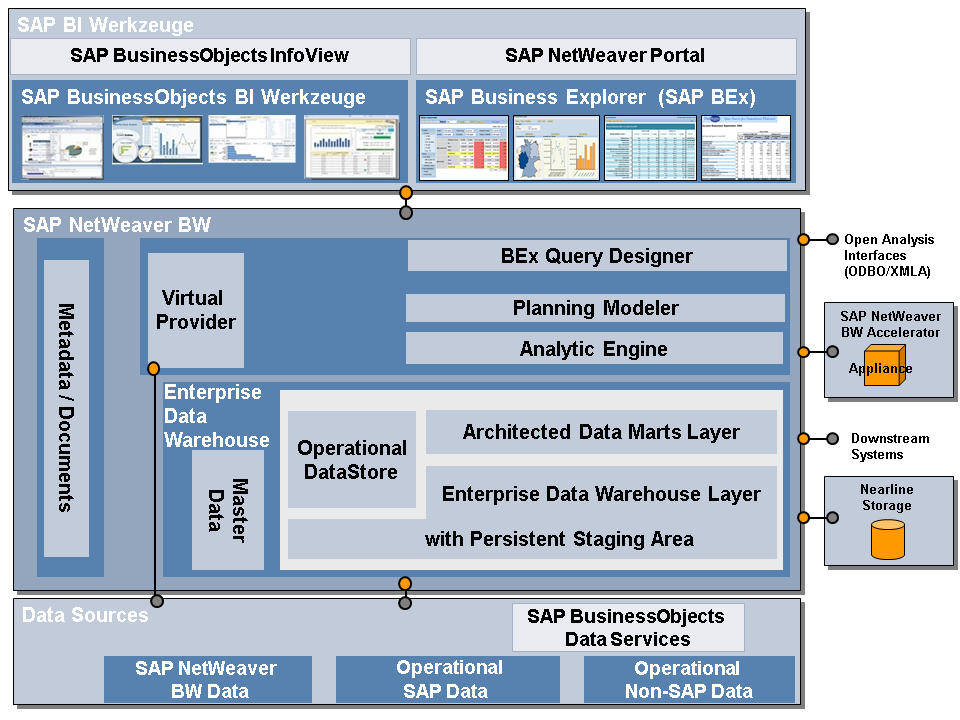
NetWeaver in SAP
SAP software has aided the growth and prosperity of enterprises all around the world. SAP ERP and SAP CRM have become essential tools for any large-scale firm. Managing all of these software solutions might be difficult at times. This is due to the large number of apps and data that these software solutions contain. NetWeaver in SAP.
As a result, SAP NetWeaver was created. It’s a platform that can easily handle different software solutions. Data from several sources can be combined in a single environment. We’ll learn more about it in this blog.
What is SAP NetWeaver?
SAP NetWeaver is SAP’s core integration platform, which supports SAP CRM and SAP ERP applications. This software can be used by businesses to combine business processes and data from several sources. It provides the framework for running a variety of application ecosystems.
You get all of the necessary tools, online services, and server features.
This aids in the seamless integration of data, systems, and applications.
- It also helps with a variety of commercial processes.
- These include:
- Finance management.
- Supply chain management.
- Customer relationship management.
- Human resource management.
It is used by developers and administrators to manage various SAP systems. It also includes other analytics tool usage kinds, such as BW & PI and Portal. It also includes extensions for big data, cloud, and mobile solutions.
SAP NetWeaver History
In 1997, Top Tier Software was released. SAP purchased this business in 2001. Later in 2004, SAP released NetWeaver 2004 as an update to SAP NetWeaver. On October 24, 2005, NetWeaver 7.0 was released. The most recent version is 7.5 SP 19.
SAP developed its components in collaboration with IT giants including Sun Microsystems, HP, and IBM. SAP NetWeaver developer tools were later created. They include-
- ABAP Workbench
- SAP NetWeaver Developer Studio
- Visual Composer
- SAP NetWeaver Development Infrastructure
Core Capabilities of SAP NetWeaver
The core capabilities include:
People Integration
SAP NetWeaver, as the name implies, allows you to bring together your employees, staff, and stakeholders. They are able to work more efficiently as a result of this. This is made possible through its portal technology, which provides users with unified and tailored access. Users can focus more on the data that is relevant to them because of the role-
based access.
SAP NetWeaver enables all employees to efficiently collaborate and communicate. Collaboration Rooms, chat, and application sharing are all available. To collaborate efficiently, you can use third-party applications like Microsoft Exchange and WebEx. Multi-Channel Access is another crucial function. You can use mobile, web, phone, or radio technology to connect to ERP systems.
Information Integration
Simply put, this means that you can combine information or data from various sources into a single spot. It enables you to decipher your data and make critical decisions.
Business Intelligence tools are available in SAP NetWeaver for creating interactive reports and apps. This can be aided by BI Content and BI Content Extensions. It also provides centralized access to unstructured data and documents. It has data-handling capabilities, such as:
- Subscription
- Classification
- Search
- Versioning
All this makes text mining and data processing easy in the case of large data sets or complicated documents.
Process Integration
Companies can use SAP NetWeaver to coordinate and manage workflows across several departments. Usage types are available in the software. These allow non-SAP and SAP systems to communicate with one another. The systems can communicate with each other even if they run on different platforms.
The NetWeaver architecture provides a number of features. Message interchange, business process management configuration choices, and message mapping are among them.
Application Platform
The SAP Web Application Server is a platform for creating, deploying, and distributing business applications and Web services. You can use ABAP on an interactive, browser-based platform to create your apps. With nearly little downtime, software engineers can manage the software development lifecycle. ABAP code analysis tools are also available in SAP NetWeaver. These aid developers in the removal of obsolete code. They have the ability to make adjustments based on the database implementation. It also aids them in improving the speed of database queries.
Features of SAP NetWeaver
Some salient features of SAP NetWeaver are:
- SAP Business Suite and SAP Business by Design is built on top of SAP NetWeaver. Partner solutions and custom-built apps are also supported.
- It integrates data from diverse sources using open technology standards. It also supports cutting-edge technologies like Big Data analytics and the Internet of Things (IoT).
- Supporting apps are developed using Java servers and ABAP (Advanced Business Application Programming).
- Changes, add, creates, and controls decision logic for IT teams and users. To foster conceptual thinking, data models are also offered.
- You can integrate multiple processes across applications using built-in functionalities. As a result, you can improve your programming model.
- A web-based platform that also serves as a base for Enterprise Service-Oriented Architecture.

SAP NetWeaver Components
It has a few important components which help business to execute the problems. These include:
1)SAP Business Information Warehouse
This software includes a business intelligence platform as well as data warehousing capabilities. Companies can utilize technologies to examine company data and make important decisions.
2)SAP Business Intelligence
Businesses can analyze data and identify hidden trends with the help of analytics and reporting technologies. Data from several sources can be combined and comprehended using this method. It can then be distributed to other departments and personnel that are affected.
3)SAP Knowledge Warehouse
This aids businesses in the creation and management of knowledge bases. Data concerning training materials, paperwork, and manuals are stored in these.
4)SAP Enterprise Portal
This is used to create user interfaces based on their roles. It helps you concentrate on the crucial tasks at hand. Furthermore, within SAP settings, enterprises can define single access points for services, apps, and data.
5)SAP Master Data Management
This enables businesses to acquire and organize data from a variety of disparate sources. All of this material has been gathered in one place.
6)SAP Mobile Infrastructure
You can develop a single interface that communicates with any device using this technology. For mobile devices, it serves as a universal translator.
7)SAP Web Application Server
SAP NetWeaver is built on this platform. This works as an engine behind all the applications and tools.
8)SAP NetWeaver Process Integration
This allows companies to integrate business processes running across different systems.
9)SAP Exchange Infrastructure
This component makes data transmission between the SAP environment and external systems easier. It also includes a template for creating adapters. These adapters allow two apps to communicate with each other.
Advantages of SAP NetWeaver
The primary advantages of SAP NetWeaver are:
- It has the ability to adapt to various business technologies and improve efficiency.
- Different suppliers can readily share applications created in different languages.
- It saves IT and administrative expenditures since a unified database can handle and process a large amount of data.
- It’s a flexible platform that can adapt to changing business needs and technological advancements. Customization of software is no longer required.
- Reduces system complexity, making it easier for employees to use the software. Furthermore, NetWeaver has a relatively gentle learning curve.
SAP NetWeaver can be thought of as an all-in-one software solution for businesses. It has had a favorable impact on their sales, development, management, and income. The platform makes it easier for systems to communicate with one another. As a result, employees, administrators, developers, and managers may all concentrate on their respective business goals.




